Traces of Industry in Tržič
In the previous century, shoemaking had a strong influence on the life of Tržič residents. Metal shoeprints on the ground will lead you along the paths of industry. They will direct you through the whole of the historic centre and draw your attention to points where shoemaking was most prevalent through history. The locations are connected together in a circular walk around Tržič that takes a bit over an hour to complete. Along the way you can view some of the cultural and tourist attractions of the town.
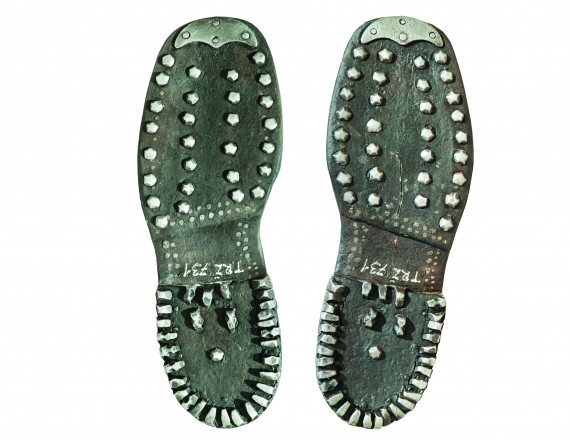 1 / 14 Traces of Industry in Tržič
1 / 14 Traces of Industry in Tržič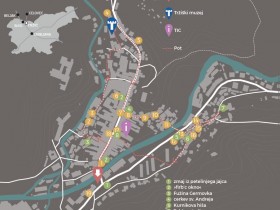 2 / 14 A map of Traces of Industry...
2 / 14 A map of Traces of Industry...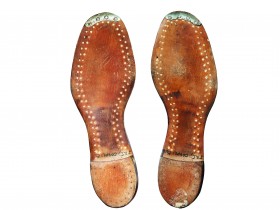 3 / 14 Traditional shoes
3 / 14 Traditional shoes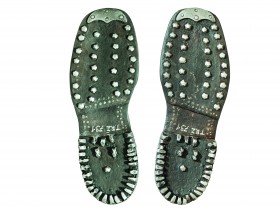 4 / 14 Traditional shoes with meta...
4 / 14 Traditional shoes with meta...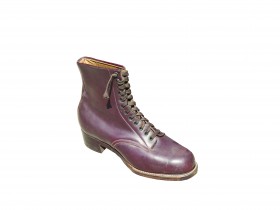 5 / 14 High-top shoes
5 / 14 High-top shoes
Tržič - the home of shoemaking heritage
Tržič is famous in Slovenia and beyond for its exceptional shoemaking heritage. The earliest shoe factories began to develop there in the 1870s, and in 1903 the Peko Shoe Factory was founded. Today shoes are manufactured in the city and nearby towns in smaller plants developed by local entrepreneurs.
Tržič has a beautiful historic town centre, where the spirit of the past is intertwined with the contemporary. The atmosphere of a 1492 market town, today a city, invites exploration.
TRACES OF INDUSTRY IN TRŽIČ
In the second half of the 19th century Tržič shoemakers began manufacturing nailed footwear. The various layers of the leather soles of shoes, boots, and other footwear were held together by wooden pins or pegs.
Durable footwear designed for use in the mountains, forests, and other rugged outdoor environments were made with hobnails, which protected the leather sole from wearing out too quickly. Nails were obtained mainly from Kropa, and shoes of this type would be worn for several decades since they were so durable.
The metal imprints of the soles (see photo) marked selected footwear plants in Tržič (see the yellow numbers on the map). From the second half of the 19th century on, the development of the town was strongly shaped by the manufacturing of footwear, which transformed handicrafts into an industry.
1. Pǝr Šlósarjǝ
There were more than ten shoemaking workshops on the main square. This house used to be the shoe shipping point of Herman Goeken. Later on they made slippers here – especially popular were slippers with tassels. Goeken opened one of the first footwear factories in Tržič, which was later taken over by Peter Kozina.
To the left of the entrance of the house Pr' Šlosarj', there is an image on the wall in the "firb'c oknu" (convex window) of the patron saints of shoemakers - Saints Crispin and Crispinian.
2. Pǝr Kaštrún
Here is where the notable Kastrun family made footwear. This house is also the birthplace of Joža Gros, the father of Miha Gros, who today owns the company Migi. The trade was passed down from generation to generation – Joža Gros even today is one of the best sources of information about the craft of artisan shoemaking. His life story is presented in the Tržič Museum.
3. Brodi
Today the Brodi company manufactures a range of slippers and other leather products, thereby continuing the Tržič shoemaking tradition - there were always some specialized slipper makers among them.
4. Pr' Hrovat
Hrovat was known for making hiking and ski boots as well as ice skates. Hiking boots were also called gojzarji - a name they acquired after the Austrian town of Bad Goisern, where they were first made.
5. Pər Fôltkə
This is the site of the former Klofutar shoemaking workshop, where custom-made footwear was made as well as ready-made items that were taken to Ljubljana and the Balkans for sale.
6. Pər Razbórškə / Jára
Janez Razboršek established a small shoe factory called Jara in this house in 1929. He employed about a hundred people. Later Trio was located here.
It was widely known that workers at Jara were very poorly paid. The lowest paid earned only a dinar per hour in the interwar period, so people called the factory the "dinar fabərka".
7. Pər Mehlét / Zgórən Vógu
The owner of this house was the well-known shoemaker and Tržič cobbler Konrad Mehle, Sr. He was an excellent shoe modeler and made orthopedic footwear as well as fine hunting boots for Baron Karl Born.
He had two sons, Konrad Jr. and Alojzij; Alojzij was educated in Vienna at the shoemaking school of Robert Knöfl, who founded the first specialized shoemaking school in 1876. Later Alojzij taught at the vocational school in Tržič.
8. Pər Komátelnek
This house was bought by master shoemaker Konrad Mehle in 1935. Prior to that footwear was made here by Janez Andošek.
9. Pər Podgórcə
This was the home of Jurij Miklavčič, a Tržič master shoemaker.
10. Pər Nôšet
The Ješe family were also among well-known Tržič shoemakers - there were over 90 workshops in the town alone. They also sold their products in Croatia, particularly Dalmatia, and further south in the Balkan Peninsula.
11. Pər Nántə
In the 19th century the master shoemaker Ferdinand Salberger lived here, and after him, his son, the shoemaker Jožef Salberger.
12. Pər Bərkè
The well-known shoemaking family Srečnik ran a workshop here, employing a number of workers. The family were known for their cheerful nature.
13. Pər Prézelnek / Pər Páckə
This house belonged to master shoemaker Matija Pleničar - Radon, who was accepted into the guild in 1826 as master shoemaker. At that time shoes were still made in a way such that the shoes for right and left feet were identical.
During the period between the wars Jožef Zupan, known as Brave Joško, lived here.
14. Špitau
Peter Jurkovič, who previously worked for Ude and Mehle, made shoes here starting in 1942.
Otherwise the Tržič poorhouse used to be sited here.
15. Pər Pútnek
Shoemakers from the Grasmajer family worked here, making up to 20,000 pairs of shoes annually. After the Second World War this factory, like most others, was nationalized, and the owners fled abroad.
16. Pər Grôgcə / Pər Molínet
In this house shoes were made by Janez Slapar during the interwar period. He and his wife were regarded as Tržič legends and the 1975 docudrama film Cobblers' Autumn was based on their lives.
17. The Mally & Demberger factory
The factory operated for a time at No. 10 Glavni Trg (Main Square) before moving to No. 18. It was founded at the beginning of the third quarter of the 19th century. The factory burned down in the 1930s.
Tržič was home not only to individual craftsmen and the Klofutar workshop, which employed a number of shoemakers, but also to two German shoe factories: the Mally & Demberger Amalgamated Shoe Factory (1874) and the Müller & Goeken Shoe Factory (1889).
The Mally & Demberger factory was founded by the brothers Philipp and Christian Demberger, the sons of a Frankfurt banker. They analysed economic conditions in Tržič and took advantage of them to establish a lucrative business. They saw a business opportunity in supplying leather and fabricated uppers to people working from home, then marketing the finished goods. Since they themselves lacked a background in shoemaking, they brought master craftsmen to Tržič who could draw the designs and tailor the leather. This type of organization of the production process did not require a lot of capital: in the beginning they did not need machinery or even a factory.
The company first operated under the name Ohr & Demberger. They rented premises in the abandoned Peharč dyeing factory. Fric Demberger eventually linked up with Karl B. Mally, who saw an opportunity for the more rational utilization of scrap leather and inferior and blemished goods from his tannery.
18. Pər Jelénc
Anton Jelenc operated a factory for making children's shoes in this building from 1921 to 1932 – they were called baby shoes. Quite a few Tržič shoemaking workshops were specialized for manufacturing children's footwear, sold as early as in the interwar years throughout the former Kingdom of Serbs, Croats, and Slovenes, much of it in Dalmatia.
Anton Jelenc is considered the pioneer of Tržić skiing.
19. Pər Gégnə
From 1893 to 1920 Julij Goeken had his shoe factory here. It was acquired, workers included, by Peter Kozina, the founder of what used to be the most modern factory in this part of Europe - Peko.
SIGHTSEEING WALK AROUND TRŽIČ
Shoeprints with wooden nails (see photo) take you by some interesting sights (see the green numbers on the map), such as:
1. The dragon from the rooster's egg
2. "firb'c okno"
This is a specially designed convex window that is very practical for the curious, and in fact that is its purpose and function for which it is adapted. In order to observe what is going on in the street you needn't even lean out of it. They say it's better than television or rather that at times it replaced television.
Similar windows were known elsewhere in Slovenia and beyond, but the "curiosity" associated with it was supposedly a specific feature of Tržič.
3. Germovka Forge
4. The Church of St. Andrew
According to reliable sources, the Church of St. Andrew stood at the upper end of the main square even before 1526. This is when there was a census of all the churches, including St. Andrew, for the purposes of collecting a tax to the Ottomans.
The present-day branch Church of St. Andrew was built in 1865 by the Škofja Loka builder Molinaro. It includes the original bell tower, which acquired its present appearance in 1929, but otherwise a Gothic church stood here as early as in the 15th century. The main and side altars from 1875 are the work of the stonecutter Anton Kalz.
In 1871 it was in this church that the Christmas song Silent Night was performed for the first time in the Slovene language, translated from the German by Jakob Aljaž, who was serving as a priest in Tržič at the time.
5. Kurnik House
6. Tekec nativity scene
7. Church of the Annunciation
There are three churches in the town of Tržič. In the single-nave neo-classicist parish Church of the Annunciation, built in the early 19th century, a silver-plated Baroque statue of Mary by the Scapular Confraternity dating from the 18th century is of particular value.
8. Town Hall
The atrium of the municipal building has a fountain adorned with a lion. Its appearance is dominated by a central pillar with sculpted plant tendrils. At the top is a crouching lion sculpture in stylized form. The lion on the pillar is a remnant of the former Glanzmann - Gassner villa in the park by the former Tržič cotton spinning and weaving mill. It is assumed that the lion sculpture arrived in Tržič through the lively trade ties of Glanzmann - Gassner with Alexandria, a powerful export warehouse for cotton. The star-shaped edge in marble next to the pillar with the fountain serves as the edge of the fountain and as a bearer of the inscriptions of places that have friendly relations with Tržič. The fountain shell, which stands independently under a cover made of Plexiglas and is carved with the coat of arms and figural decoration, marks it as a castle fountain. During transfers, the shell comes apart into three pieces, the junctions of which are still visible today.
In the atrium of the municipal building is also located the Tržič Tourism Promotion and Information Centre. It provides information for the local population (organization of events, ticket sales for events of other organizers, etc.) as well as for visitors from elsewhere (organization of guided tours, sales of souvenir shops, publications, maps, etc.).
